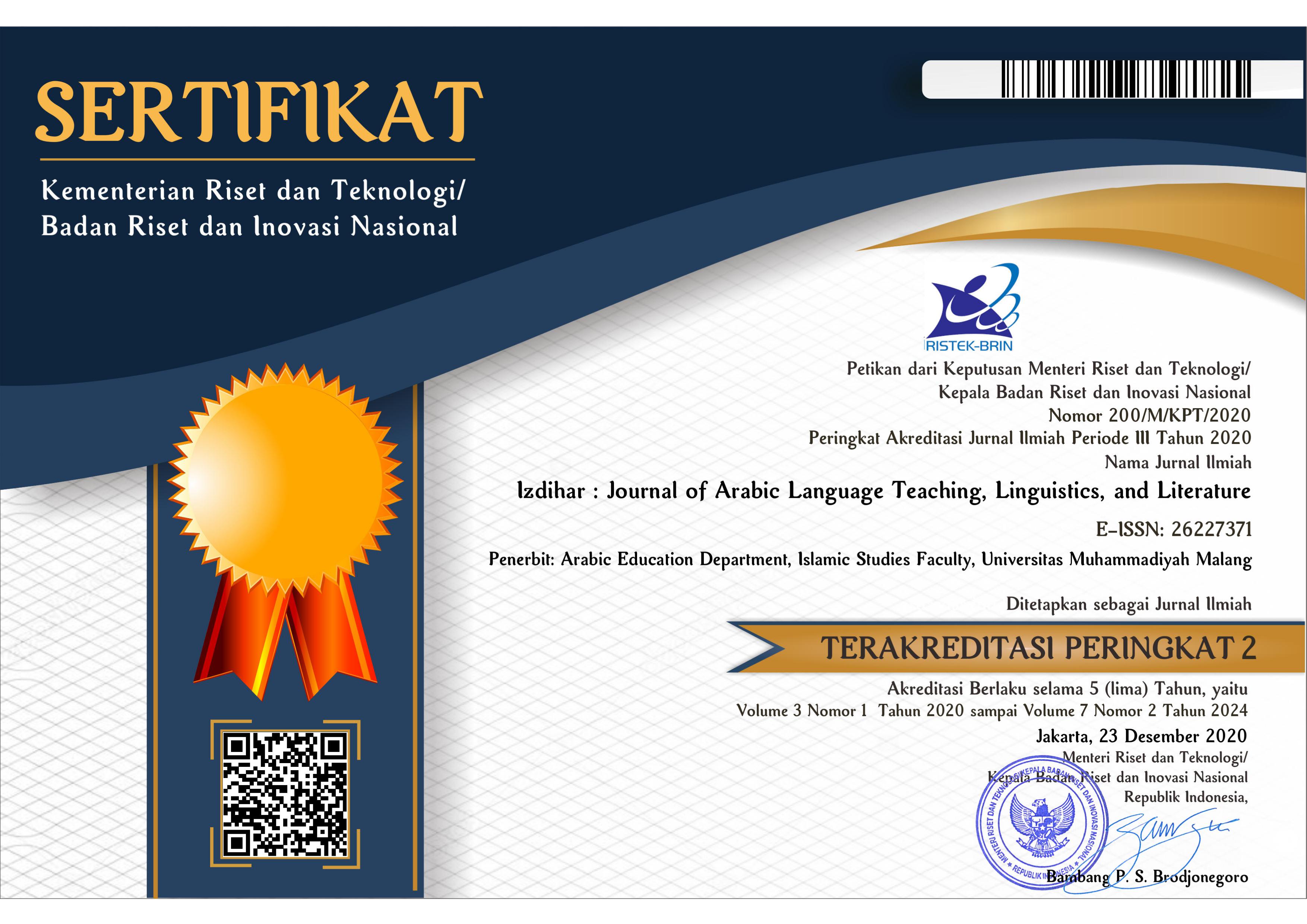Comparative Analysis of Kaba, Al-’Ashri and Al-Bisri Dictionaries (Lexicography Studies)
DOI:
https://doi.org/10.22219/jiz.v4i1.15792Keywords:
Comparative Analysis; Dictionary; LexicographyAbstract
Dictionaries are one of the means of finding vocabulary, especially in foreign languages. Besides, the dictionary also provides other information related to phonology, syntax, semantics, maps, profiles of a person, and others. Although not all dictionaries collect all the information needed by the user. But with a dictionary, it becomes easier to understand a word. The purpose of this study was to compile Kamus Akbar Bahasa Arab (KABA), Al-'Ashri, and Al-Bisri seen from the point of view of lexicography through comparative scalpels by looking at the aspects of the purpose, content, and shape of the three components of the dictionary. Besides, the author also described the similarities and differences among the three dictionaries. This study used a qualitative descriptive method. This type of research is a library research with research objects were Kamus Akbar Arabic (KABA), Al-'Asri, and Al-Bisri. Data collection used of this study was documentation and recording techniques. The data were analyzed using comparative methods. The results of this study showed that the three dictionaries had their advantages and disadvantages. However, observers or Arabic learners can choose one of these three dictionaries according to their purpose
Downloads
References
Adamska-Sałaciak, A. (2019). Lexicography and theory: Clearing the ground. International Journal of Lexicography, 32(1), 1–19. https://doi.org/https://doi.org/10.1093/ijl/ecy017
Ahmad, I. F. (2020). Asesmen alternatif dalam pembelajaran jarak jauh pada masa darurat penyebaran coronavirus disease (Covid-19) di Indonesia. Pedagogik: Jurnal Pendidikan, 7(1), 195–222. https://doi.org/https://doi.org/10.33650/pjp.v7i1.1136
Ali, A., & Muhdlor, A. Z. (1996). Al-‘Ashri (Arab-Indonesia). Multi Karya Grafika Pondok Krapyak.
Almujahid, A. T. H., & Alkhalil, A. A. F. (2013). Kamus akbar bahasa Arab (KABA) Indonesia-Arab (Pertama). Gema Insani.
Ansori, Y. Z. (2020). Pembinaan karakter siswa melalui pembelajaran terpadu di sekolah dasar. Jurnal Educatio FKIP UNMA, 6(1), 177–186. https://doi.org/https://do i.org/10.31949/educatio.v6i1. 3 08
Assarroudi, A., Heshmati Nabavi, F., Armat, M. R., Ebadi, A., & Vaismoradi, M. (2018). Directed qualitative content analysis: The description and elaboration of its underpinning methods and data analysis process. Journal of Research in Nursing, 23(1), 42–55. https://doi.org/https://doi.org/10.1177/1744987117741667
Atmowardoyo, H. (2018). Research methods in tefl studies: Descriptive research, case study, error analysis, and r & d. Journal of Language Teaching and Research, 9(1), 197–204. https://doi.org/http://dx.doi.org/10.17507/jltr.0901.25
Azhari, M. F. (2020). Development of the Arabic-Indonesian Dictionary And Indonesian-Arabic Dictionary (Historical And Systematic Study). Al-Ishlah : Jurnal Pendidikan, 12(1), 67–80. https://doi.org/10.35445/alishlah.v12i1.190
Bisri, M. A., Fatah, M. A., Munawwir, A. W., & Bisri, A. M. (1999). Kamus Al-Bisri: Indonesia-Arab, Arab-Indonesia. Pustaka Progressif.
Busro, M. (2016). Sejarah perkamusan bahasa arab di Indonesia. El-Wasathiya: Jurnal Studi Agama, 4(2), 15–33. Retrieved from http://ejournal.kopertais4.or.id/mataraman/index.php/washatiya/article/view/2636
Chelliah, S. L. (2021). Methods in language documentation and description. Why Language Documentation Matters, 69–84. https://doi.org/https://doi.org/10.1007/978-3-030-66190-8_6
Churohmah, F. (2016). Perbandingan komponen kelengkapan kamus pada kamus bilingual menurut ali al-qasimi antara kamus al-munawwir dan a dictionary of modern written Arabic (Studi Leksikografi). UIN Sunan Kalijaga Yogyakarta. Retrieved from http://digilib.uin-suka.ac.id/22847/
Deutsch, L. S., Resch, K., Barber, T., Zuckerman, Y., Stone, J. T., & Cerulli, C. (2017). Bruise documentation, race and barriers to seeking legal relief for intimate partner violence survivors: A retrospective qualitative study. Journal of Family Violence, 32(8), 767–773. https://doi.org/https://doi.org/10.1007/s10896-017-9917-4
Dewandono, W. A. (2020). Leksikologi dan leksikografi dalam pembuatan dan pemaknaan kamus. Paramasastra, 7(1), 16–26. https://doi.org/http://dx.doi.org/10.26740/parama.v7n1.p16
Dollinger, S. (2020). English lexicography: A global perspective. The Handbook of English Linguistics. Wiley Online Library. https://doi.org/https://doi.org/10.1002/9781119540618.ch26
Harbin, M. B. (2020). Collaborative note-taking: A tool for creating a more inclusive college classroom. College Teaching, 68(4), 214–220. https://doi.org/https://doi.org/10.1080/87567555.2020.1786664
Harun, U. B. (2019). Analisis komponen kamus al-mufied indonesia-arab perspektif Dr. Ali Al-Qasimy. In Prosiding Konferensi Nasional Bahasa Arab (Vol. 5, pp. 639–647). Retrieved from http://prosiding.arab-um.com/index.php/konasbara/article/view/531
Hasanah, E., Sofyan, A., & S., A. E. R. (2015). Analisis komparatif antara bahasa Jawa dialek Jember Dan Bahasa Jawa Standar. Publik Budaya, 1(1), 1–11. Retrieved from http://repository.unej.ac.id/handle/123456789/71135
Hayani, F. (2019). Leksikografi Arab (Sebuah Kajian Linguistik Terapan). Shaut Al Arabiyyah, 7(1), 1–12. https://doi.org/https://doi.org/10.24252/saa.v1i1.7786
Hidayah, N., & Qomariah, U. K. (2020). Kamus Tematik sains sebagai upaya meningkatkan penguasaan kosa kata bahasa Arab mahasiswa biologi. Al-Lahjah, 5(2), 20–28. https://doi.org/https://doi.org/10.32764/lahjah.v5i2.886
Huda, N., & Ulfah, N. (2019). Pengembangan kamus Arab-Indonesia sebagai penunjang penggunaan buku ajar Madrasah Tsanawiyah di kelas VIII. Alfazuna: Jurnal Pembelajaran Bahasa Arab Dan Kebahasaaraban, 3(2), 211–230. https://doi.org/https://doi.org/10.15642/alfazuna.v3i2.533
Invernizzi, D. C., Locatelli, G., Brookes, N., & Davis, A. (2020). qualitative comparative analysis as a method for project studies: The Case of Energy Infrastructure. Renewable and Sustainable Energy Reviews, 133, 110314. https://doi.org/https://doi.org/10.1016/j.rser.2020.110314
Karthick, S., & Maniraj, S. (2019). Different medical image registration techniques: A comparative analysis. Current Medical Imaging, 15(10), 911–921. https://doi.org/https://doi.org/10.2174/1573405614666180905094032
Khasanah, U. (2015). Penggunaan Ebook Kamus Al-Munawwir Sebagai Media Pembelajaran Pada Mahasantri Ma’had ‘Aly Al Tarmasie Perguruan Islam Pondok Tremas Pacitan Jawa Timur Semester 1 Tahun Ajaran 1435-1436 H. UIN Sunan Kalijaga Yogyakarta. Retrieved from http://digilib.uin-suka.ac.id/16112/
Ma, Q. (2019). University l2 learners’ voices and experience in making use of dictionary apps in mobile assisted language learning (MALL). International Journal of Computer-Assisted Language Learning and Teaching (IJCALLT), 9(4), 18–36. https://doi.org/10.4018/IJCALLT.2019100102
Mottahedeh, R. P. (2018). Medieval lexicography on Arabic and Persian terms for city and countryside. Eurasian Studies, 16(1–2), 465–478. https://doi.org/https://doi.org/10.1163/24685623-12340060
Mustaufiy, A. S. H., & Sadat, A. (2020). Analisis preferensi mahasiswa terhadap penggunaan kamus dalam mempelajari bahasa Arab. AL-AF’IDAH: Jurnal Pendidikan Bahasa Arab Dan Pengajarannya, 4(1), 1–17. Retrieved from http://ejournal.iaimbima.ac.id/index.php/afidah/article/view/462
Nasution, S. (2017). Pengantar linguistik bahasa Arab. (M. Kholison, Ed.) (I). Sidoarjo: Lisan Arabi. Retrieved from http://repository.uinsu.ac.id/2034/1/6. Buku Linguistik Arab.pdf
Nikmah, K. (2019). Interrogative sentence: A contrastive study of arabic and indonesian. Izdihar: Journal of Arabic Language Teaching, Linguistics, and Literature, 2(3), 183–200. https://doi.org/https://doi.org/10.22219/jiz.v2i3.10148
Nur, T. (2016). Analisis kontrastif dalam studi bahasa. Arabi : Journal of Arabic Studies, 1(2), 64–74. https://doi.org/10.24865/ajas.v1i2.11
Nurmila, N. (2020). Improving the students’ reading skill trough note-taking technique: A Pre-experimental research. Journal La Edusci, 1(1), 25–32. https://doi.org/10.37899/journallaedusci.v1i1.29
Shayakhmetov, O. M., Imasheva, G. Y., Almukhametov, A. R., Mukhitdinov, R. S., & Paltore, Y. (2018). Systematising the microstructure of a modern dictionary of the Arabic language. Space and Culture, India, 6(2), 34–45. https://doi.org/https://doi.org/10.20896/saci.v6i2.340
Thoyyibah, A. (2013). Musahamah fayruzzabadi fi tatwir al mu’jam Al ’Arabiy (Dirasah Tahliliyyah Wasfiyyah). UIN Sunan Kalijaga Yogyakarta. Retrieved from http://digilib.uin-suka.ac.id/9443/
Thoyyibah, A. (2018). Khutbah Thariq bin Ziyad (Kajian Stilistika Arab). Alfaz (Arabic Literatures for Academic Zealots), 6(2), 109–126. https://doi.org/http://dx.doi.org/10.32678/alfaz.Vol6.Iss02.1383
Thoyyibah, A. (2019). Analisis kesalahan ortografi bahasa Arab Mahasiswa pendidikan bahasa Arab Universitas Muhammadiyah Malang. Arabiyatuna: Jurnal Bahasa Arab, 3(2), 215–334. https://doi.org/http://dx.doi.org/10.29240/jba.v3i2.1017
Wahab, M. A. (2017). Peta perkembangan leksikografi Arab di Indonesia: Studi kritis atas kamus karya Mahmud Yunus. Arabi: Journal of Arabic Studies, 2(1), 19–36. https://doi.org/http://dx.doi.org/10.24865/ajas.v2i1.31
Walidah, Z., Yanuar, M., Azizah, D. N., & Qalyubi, S. (2020). Stylistic Analysis in Surah Al-Najm. Izdihar: Journal of Arabic Language Teaching, Linguistics, and Literature, 3(2), 129–146. https://doi.org/https://doi.org/10.22219/jiz.v3i2.11624
Widayat, P. A. (2019). Kitābu Al-‘Ain: Metode penggunaan dan pengaruhnya dalam perkembangan kosakata bahasa arab. Al-Fathin: Jurnal Bahasa Dan Sastra Arab, 2(1), 95–110. https://doi.org/https://doi.org/10.32332/al-fathin.v2i2.1424
Widyaningsih, G. E. N. (2019). Penggunaan kamus digital dan kamus cetak terhadap penguasaan Hanzi. Jurnal Ilmiah Edukasi & Sosial, 10(1), 34–41. Retrieved from http://jiesjournal.com/index.php/jies/article/view/187
Xu, Z., Zayed, T., & Niu, Y. (2020). Comparative analysis of modular construction practices in Mainland China, Hong Kong and Singapore. Journal of Cleaner Production, 245, 118861. https://doi.org/https://doi.org/10.1016/j.jclepro.2019.118861
Downloads
Published
How to Cite
Issue
Section
License
Copyright (c) 2021 Anisatu Thoyyibah, Izdihar : Journal of Arabic Language Teaching, Linguistics, and Literature

This work is licensed under a Creative Commons Attribution-ShareAlike 4.0 International License.
Copyright Notice
Authors who publish with this journal agree to the following terms:
- Authors retain copyright and grant the journal right of first publication with the work simultaneously licensed under a Creative Commons Attribution-ShareAlike 4.0 International License that allows others to share the work with an acknowledgment of the work's authorship and initial publication in this journal.
- Authors are able to enter into separate, additional contractual arrangements for the non-exclusive distribution of the journal's published version of the work (e.g., post it to an institutional repository or publish it in a book), with an acknowledgment of its initial publication in this journal.
- Authors are permitted and encouraged to post their work online (e.g., in institutional repositories or on their website) prior to and during the submission process, as it can lead to productive exchanges, as well as earlier and greater citation of published work (See The Effect of Open Access).
Copyright (c) 2019 Izdihar : Journal of Arabic Language Teaching, Linguistics, and Literature

This work is licensed under a Creative Commons Attribution-ShareAlike 4.0 International License.


















